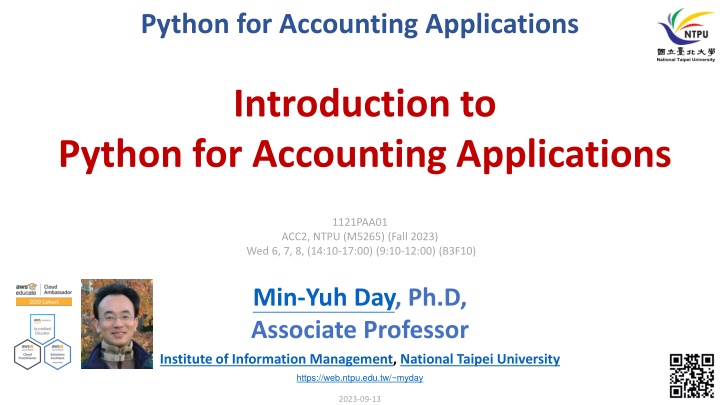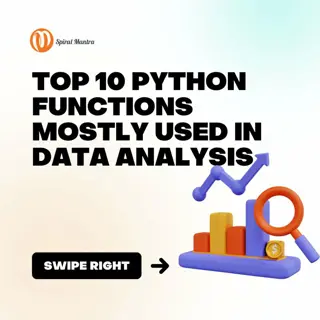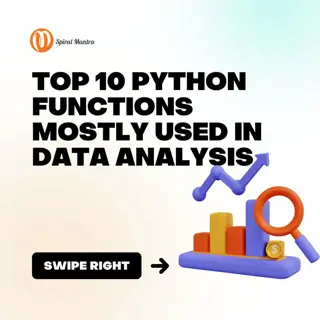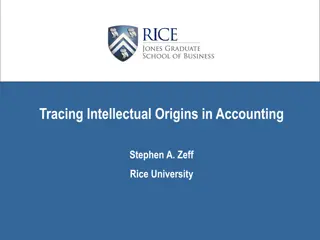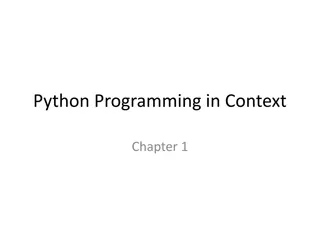Python for Accounting Applications at NTPU
This course at National Taipei University delves into Python for Accounting Applications, covering topics like Python programming, data science, data structures, control logic, functions, file handling, data analytics, statistical analysis, machine learning, text analytics, and more. Taught by Dr. Min-Yuh Day, students will gain hands-on experience and understanding of utilizing Python for accounting purposes.
Download Presentation

Please find below an Image/Link to download the presentation.
The content on the website is provided AS IS for your information and personal use only. It may not be sold, licensed, or shared on other websites without obtaining consent from the author.If you encounter any issues during the download, it is possible that the publisher has removed the file from their server.
You are allowed to download the files provided on this website for personal or commercial use, subject to the condition that they are used lawfully. All files are the property of their respective owners.
The content on the website is provided AS IS for your information and personal use only. It may not be sold, licensed, or shared on other websites without obtaining consent from the author.
E N D
Presentation Transcript
Python for Accounting Applications Introduction to Python for Accounting Applications 1121PAA01 ACC2, NTPU (M5265) (Fall 2023) Wed 6, 7, 8, (14:10-17:00) (9:10-12:00) (B3F10) Min-Yuh Day, Ph.D, Associate Professor Institute of Information Management, National Taipei University https://web.ntpu.edu.tw/~myday 1 2023-09-13
Min-Yuh Day, Ph.D. Associate Professor, Information Management, NTPU Visiting Scholar, IIS, Academia Sinica Ph.D., Information Management, NTU Director, Intelligent Financial Innovation Technology, IFIT Lab, IM, NTPU Associate Director, Fintech and Green Finance Center, NTPU Artificial Intelligence, Financial Technology, Big Data Analytics, Data Mining and Text Mining, Electronic Commerce 2
Course Syllabus National Taipei University Academic Year 112, 1st Semester (Fall 2023) Course Title: Python for Accounting Applications Instructor: Min-Yuh Day Course Class: ACC2, NTPU (3 Credits, Elective) Details EMI Course (3 Credits, Elective, One Semester) (U2004) Time & Place: Wed. 6, 7, 8, 14:10-17:00(B3F17) Google Meet: https://meet.google.com/ofh-iosa-ehd 3
Course Objectives 1.Understand the fundamental concepts of Python for Accounting Applications. 2.Equip with Hands-on practices of Python for Accounting Applications. 4
Course Outline This course introduces the fundamental concepts and hands-on practices of Python for Accounting Applications. Topics include 1. Introduction to Python for Accounting Applications, 2. Python Programming and Data Science, 3. Foundations of Python Programming, 4. Data Structures, 5. Control Logic and Loops, 6. Functions and Modules, 7. Files and Exception Handling, 8. Data Analytics and Visualization with Python, 9. Obtaining Data From the Web with Python, 10. Statistical Analysis with Python, 11. Machine Learning with Python, 12. Text Analytics with Python and Large Language Models (LLMs), 13. Applications of Accounting Data Analytics with Python, and 14. Applications of ESG Data Analytics with Python. 5
Syllabus Week Date Subject/Topics 1 2023/09/13 Introduction to Python for Accounting Applications 2 2023/09/20 Python Programming and Data Science 3 2023/09/27 Foundations of Python Programming 4 2023/10/04 Data Structures 5 2023/10/11 Control Logic and Loops 6 2023/10/18 Functions and Modules 7 2023/10/25 Files and Exception Handling 8 2023/11/01 Midterm Project Report 6
Syllabus Week Date Subject/Topics 9 2023/11/08 Data Analytics and Visualization with Python 10 2023/11/15 Obtaining Data From the Web with Python 11 2023/11/22 Statistical Analysis with Python 12 2023/11/29 Machine Learning with Python 13 2023/12/06 Text Analytics with Python and Large Language Models (LLMs) 14 2023/12/13 Applications of Accounting Data Analytics with Python 15 2023/12/20 Applications of ESG Data Analytics with Python 16 2023/12/27 Final Project Report 7
Teaching Methods and Activities Lecture Discussion Practicum 8
Evaluation Methods Individual Presentation 30 % Group Presentation 30 % Case Report 20 % Class Participation 10 % Assignment 10 % 9
Required Texts Allen B. Downey (2016), Think Python: How to Think Like a Computer Scientist, 2nd Edition, O Reilly Media 10
Reference Books 1. Frederick Kaefer and Paul Kaefer (2020), Introduction to Python Programming for Business and Social Science Applications, SAGE Publications 2. Abdullah Karasan (2021), Machine Learning for Financial Risk Management with Python: Algorithms for Modeling Risk, O Reilly Media 3. Vic Anand, Khrystyna Bochkay, and Roman Chychyla (2020), Using Python for Text Analysis in Accounting Research, Now Publishers 4. Aur lien G ron (2022), Hands-On Machine Learning with Scikit-Learn, Keras, and TensorFlow: Concepts, Tools, and Techniques to Build Intelligent Systems, 3rd Edition, O Reilly Media. 5. Yves Hilpisch (2018), Python for Finance: Mastering Data-Driven Finance, 2nd Edition, O'Reilly Media. 6. Yves Hilpisch (2020), Artificial Intelligence in Finance: A Python-Based Guide, O Reilly Media. 11
Other References Python, https://www.python.org/ 12
Green Finance and Sustainable Finance 13
Evolution of Sustainable Finance Research Topic SDGs SDGs: Sustainable Development Goals Innovative Financial Instrument Impact Investing ESG: Environmental, Social, and Governance CSR: Corporate Social Responsibility Conscious Capitalism Climate Financing Carbon Financing Green Financing Ethical Investing Socially Responsible Investing 1986 1995 2005 2015 2020 Source: Kumar, S., Sharma, D., Rao, S., Lim, W. M., & Mangla, S. K. (2022). Past, present, and future of sustainable finance: Insights from big data analytics through machine learning of scholarly research. Annals of Operations Research, 1-44. 14
AI for Environmental, Social, and Governance (AI4ESG) Source: Nenad Toma ev, Julien Cornebise, Frank Hutter, Shakir Mohamed, Angela Picciariello, Bec Connelly, Danielle Belgrave et al. (2020) "AI for social good: unlocking the opportunity for positive impact." Nature Communications 11, no. 1: 1-6. 15
AI for Social Good (AI4SG) Source: Nenad Toma ev, Julien Cornebise, Frank Hutter, Shakir Mohamed, Angela Picciariello, Bec Connelly, Danielle Belgrave et al. (2020) "AI for social good: unlocking the opportunity for positive impact." Nature Communications 11, no. 1: 1-6. 16
Sustainability SDGs CSR ESG 17
Sustainable Development Goals (SDGs) 18 Source: https://sdgs.un.org/goals
Sustainable Development Goals (SDGs) and 5P Partnership Peace Prosperity People Planet 19 Source: Folke, Carl, Reinette Biggs, Albert V. Norstr m, Belinda Reyers, and Johan Rockstr m. "Social-ecological resilience and biosphere-based sustainability science. Ecology and Society 21, no. 3 (2016).
Green Finance Generic term implying use or diversion of financial resources to deploy and support projects with long term positive impact on the environment 20 Source: Bhattacharyya, Rupsha. "Green finance for energy transition, climate action and sustainable development: overview of concepts, applications, implementation and challenges." Green Finance 4, no. 1 (2022): 1-35.
Sustainable Finance Finances deployed in support of projects that ensure just, sustainable and inclusive growth or attainment of one or more sustainable development goals 21 Source: Bhattacharyya, Rupsha. "Green finance for energy transition, climate action and sustainable development: overview of concepts, applications, implementation and challenges." Green Finance 4, no. 1 (2022): 1-35.
Carbon Finance Financial instruments based on economic value of carbon emissions which an organization cannot avoid but which it offsets by funding other compensatory projects that contribute to carbon emissions reduction 22 Source: Bhattacharyya, Rupsha. "Green finance for energy transition, climate action and sustainable development: overview of concepts, applications, implementation and challenges." Green Finance 4, no. 1 (2022): 1-35.
Climate Finance Finances deployed in support of low carbon and climate resilient projects that help in climate change mitigation and adaptation efforts, particularly in the energy and infrastructure sectors 23 Source: Bhattacharyya, Rupsha. "Green finance for energy transition, climate action and sustainable development: overview of concepts, applications, implementation and challenges." Green Finance 4, no. 1 (2022): 1-35.
ESG Investing Investments considering the broad range of environmental (e.g. climate change, pollution biodiversity loss), social (e.g. working conditions, human rights, salary or compensation structures) and governance (e.g. board composition, diversity and inclusion, taxes) characteristics of the projects or companies being invested in; ethical and business sustainability considerations are integral part of financing 24 Source: Bhattacharyya, Rupsha. "Green finance for energy transition, climate action and sustainable development: overview of concepts, applications, implementation and challenges." Green Finance 4, no. 1 (2022): 1-35.
Impact Investing Investing in projects that solve a social or environmental problem; the focus is on the positive impact rather than the means used to produce that impact 25 Source: Bhattacharyya, Rupsha. "Green finance for energy transition, climate action and sustainable development: overview of concepts, applications, implementation and challenges." Green Finance 4, no. 1 (2022): 1-35.
Dynamic Trends of Green Finance and Energy Policy 26 Source: Wang, Moran, Xuerong Li, and Shouyang Wang. (2021) "Discovering research trends and opportunities of green finance and energy policy: A data-driven scientometric analysis." Energy Policy 154 (2021): 112295.
ESG: Environmental Social Governance 27
CSR: Corporate Social Responsibility 28
ESG to 17 SDGs 29 Source: Henrik Skaug S tra (2021) "A Framework for Evaluating and Disclosing the ESG Related Impacts of AI with the SDGs." Sustainability 13, no. 15 (2021): 8503.
ESG to 17 SDGs 30 Source: https://sustainometric.com/esg-to-sdgs-connected-paths-to-a-sustainable-future/
Generative AI for ESG Applications 31
AI and Sustainability Development Goals (SDGs) Source: Schoormann, T., Strobel, G., M ller, F., Petrik, D., & Zschech, P. (2023). 32 Artificial Intelligence for Sustainability A Systematic Review of Information Systems Literature. Communications of the Association for Information Systems, 52(1), 8.
AI for Sustainability Source: Schoormann, T., Strobel, G., M ller, F., Petrik, D., & Zschech, P. (2023). 33 Artificial Intelligence for Sustainability A Systematic Review of Information Systems Literature. Communications of the Association for Information Systems, 52(1), 8.
Sustainable Productivity: Finance ESG 34 Source: Huang, Ziqi, Yang Shen, Jiayi Li, Marcel Fey, and Christian Brecher (2021). "A survey on AI-driven digital twins in Industry 4.0: Smart manufacturing and advanced robotics." Sensors 21, no. 19: 6340.
Sustainable Resilient Manufacturing ESG 35 Source: Huang, Ziqi, Yang Shen, Jiayi Li, Marcel Fey, and Christian Brecher (2021). "A survey on AI-driven digital twins in Industry 4.0: Smart manufacturing and advanced robotics." Sensors 21, no. 19: 6340.
ESG Indexes MSCI ESG Index Dow Jones Sustainability Indices (DJSI) FTSE ESG Index 36
MSCI ESG Rating Framework 37 Source: https://www.msci.com/documents/1296102/21901542/ESG-Ratings-Methodology-Exec-Summary.pdf
MSCI ESG Key Issue Hierarchy 38 Source: https://www.msci.com/documents/1296102/21901542/ESG-Ratings-Methodology-Exec-Summary.pdf
MSCI Governance Model Structure 39 Source: https://www.msci.com/documents/1296102/21901542/ESG-Ratings-Methodology-Exec-Summary.pdf
MSCI Hierarchy of ESG Scores 40 Source: https://www.msci.com/documents/1296102/21901542/ESG-Ratings-Methodology-Exec-Summary.pdf
DJSI S&P Global ESG Score 41 Source: DJSI, S&P Global Corporate Sustainability Assessment (CSA), https://www.spglobal.com/esg/solutions/data-intelligence-esg-scores
FTSE Russell ESG Ratings 42 Source: https://www.ftserussell.com/data/sustainability-and-esg-data/esg-ratings
Sustainalytics ESG Risk Ratings Analyst-based approach Sustainalytics ESG Risk Ratings measure a company s exposure to industry-specific material ESG risks and how well a company is managing those risks. 43 Source: https://www.sustainalytics.com/esg-data
TruValue Labs Truvalue ESG Ranks Machine-based approach Truvalue Labs applies AI to analyze over 100,000 sources and uncover ESG risks and opportunities hidden in unstructured text. The ESG Ranks data service produces an overall company rank based on industry percentile leveraging the 26 ESG categories defined by the Sustainability Accounting Standards Board (SASB). The data feed covers 20,000+ companies with more than 13 years of history. 44 Source: :https://developer.truvaluelabs.com/data/esg-ranks
Analyst-driven vs. AI-driven ESG Sustainalytics Truvalue Labs Source: Mark Tulay (2020), Man vs. machine: A tale of two sustainability ratings systems, GreenBiz, https://www.greenbiz.com/article/man-vs-machine-tale-two-sustainability-ratings-systems 45
Analyst based ESG Research AI based ESG Research 46 Source: https://www.esganalytics.io/insights/how-data-is-accelerating-esg
ESG Analytics: NLP Taxonomy 47 Source: https://www.esganalytics.io/insights/how-data-is-accelerating-esg
Top ESG Reporting Software Environmental, Social and Governance (ESG) Reporting software or Sustainability software helps organizations manage their operational data, evaluate their impact on the environment and provide reporting to perform audits. 48 Source: https://www.softwarereviews.com/categories/environmental-social-and-governance-reporting
ESG Reporting Software: Emitwise Emitwise is the carbon management platform for companies with complex manufacturing supply chains to confidently understand, track and reduce their complete carbon footprint. Combining 100 years of carbon accounting experience and machine learning technology, we accelerate climate action by increasing the accuracy of scope 3 emissions. The platform empowers manufacturers and their supply chains to make carbon-led business decisions that lower risk, increase profitability and deliver ambitious climate action. 49 Source: https://www.softwarereviews.com/categories/environmental-social-and-governance-reporting
ESG Reporting Software: Workiva ESG Workiva is a cloud native platform that simplifies the complexities of reporting and compliance. Workiva ESG is the end-to-end platform that allows you to integrate financial data, nonfinancial data, and XBRL. Workiva, the platform that streamlines your entire ESG process. Automate data collection, utilize frameworks, and directly connect to all your ESG reports. in meaningful glossy reports, accurate survey responses, and regulatory filings with integrated XBRL tagging. 50 Source: https://www.softwarereviews.com/categories/environmental-social-and-governance-reporting
